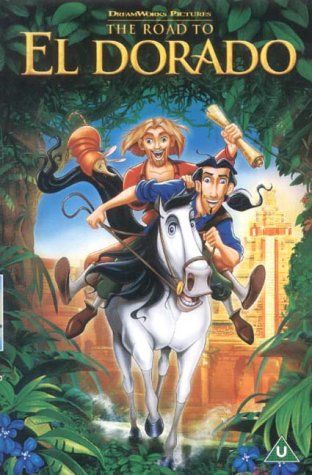"Comic Myth-Adventures"

| None | Light | Moderate | Heavy | |
|---|---|---|---|---|
| Language | ||||
| Violence | ||||
| Sex | ||||
| Nudity |
What You Need To Know:
THE ROAD TO EL DORADO is a colorful, sometimes exciting movie, with lots of humor. The good-natured story is spoiled, however, by references to pagan religion and a scary monster conjured up by the evil priest, who is defeated by human effort. Despite these and other problems, such as some naturalistic nudity, the movie has several strong positive qualities. It teaches, for example, moral principles like honesty, friendship, kindness, and respect for human life.
Content:
(RoRo, BB, HH, RH, Pa, O, Ab, L, V, N, AA, D, M) Romantic worldview regarding primitive cultures & the nature of man, with many moral virtues plus humanist elements, revisionist history regarding the Christian worldview of the Spanish conquistador, Cortes, & some pagan elements which are rebuked, such as occult pagan villain advocates human sacrifice & conjures demonic monster; 3 mild obscenities & 2 or 3 mild profanities; action & slapstick violence such as swordfights, men jump into barrels, & men fight scary demonic monster; no sex but scantily-clad heroine seduces, kisses & embraces one hero; heroine wears sexy, revealing outfit & upper & rear male nudity in naturalistic contexts; alcohol use & drunkennes; smoking; and, gambling & deceit from heroes, with deceit eventually being rebuked.
More Detail:
Old-fashioned adventure invades the world of animation in DreamWorks’ (THE PRINCE OF EGYPT and ANTZ) new feature-length cartoon, THE ROAD TO EL DORADO.
Starring the voices of Kevin Kline, Kenneth Branagh and Rosie Perez, the movie tells the tale of two Spanish con men in the 1500s, Tulio (Kline) and Miguel (Branagh), who find a map to the fabled golden city of El Dorado. In a series of comic misadventures, they get caught as unintentional stowaways on a ship bound for the New World, under the command of a materialistic Cortes, the Spanish conquistador. With the help of a kindly war-horse named Altivo, they escape, only to find themselves adrift on a longboat with the horse.
Eventually, Tulio, Miguel and Altivo discover El Dorado, but are mistaken for two gods who were foretold by the tribe’s pagan prophecies. There is a power struggle in the tribe, however, between the very chubby chief and the evil pagan priest, Tzekel-Kan. With the help of a sexy young maiden named Chel (voiced by Rosie Perez), Tulio and Miguel decide to continue posing as gods and take off with some of the tribe’s gold. Complicating this plan is Tulio’s growing feelings for Chel and Miguel’s growing friendship with the kindly tribespeople. When Tzekel-Kan becomes wise to their plan, he conjures up a demonic monster to destroy them and take over the tribe. Meanwhile, Cortes and his warriors are hot on Tulio and Miguel’s trail. Can Miguel and Tulio save the city, and their friendship, in time?
A colorful, sometimes exciting movie, THE ROAD TO EL DORADO also has lots of humor. Particularly enjoyable are the movie’s long opening sequence (though it starts a little too suddenly) and a unique soccer-style game between the two phony “gods,” Tulio and Miguel, and a bunch of Mayan warriors. Younger children will understand the soccer game better than they may understand the early parts of the opening sequence. Those early parts involve some complicated character development and complex dialogue. Younger children also may be too scared by the monster that the evil priest conjures to kill the two heroes.
The worldview of THE ROAD TO EL DORADO is mixed. It teaches, for example, many moral elements, such as honesty, friendship, kindness, and respect for human life. It also rebukes the evil occult paganism of the priest, Tzekel-Kan, including his demonic, idolatrous desires for human sacrifice.
These moral qualities are undercut by a humanistic attitude which exalts human effort. Such an attitude leaves God out of the equation entirely. There is also one scene where the movie mocks the pagan priest’s belief that human beings have a strongly sinful nature. The priest’s solution to this problem is to frighten the people into behaving properly by holding regular human sacrifices. Of course, the Christian solution is belief in Jesus Christ, who died in our place so that we can receive eternal life. Thus, this scene reflects the movie’s humanistic and romantic elements.
Romanticism believes, contrary to biblical truth, that human beings are essentially good and that primitive societies, like the one appearing in THE ROAD TO EL DORADO, reflect such goodness. That’s not, however, what anthropologists have actually discovered. It is also interesting to note the view of the late anthropologist, Sir Edward Evans-Pritchard, who found that, in most primitive societies, the religious and spiritual beliefs of the people are mixed. In fact, he and other scholars have shown that it is not unusual to find a primitive ethical monotheism within such communities. As Paul writes in Romans 1:20, “Since the creation of the world, God’s invisible qualities – his eternal power and divine nature – have been clearly seen, being understood from what has been made, so that men are without excuse.”
If all this sounds a little too deep for just an animated children’s adventure, perhaps the writers should not have ventured into such complicated theological territory. Sometimes, the road to box office gold is a messy one.



 - Content:
- Content: 




